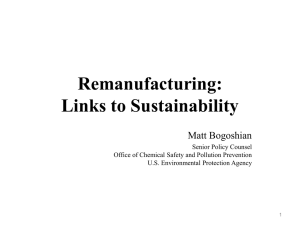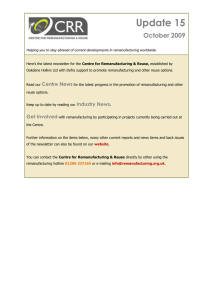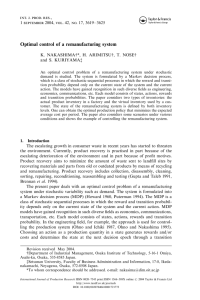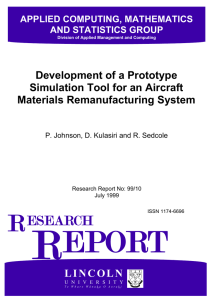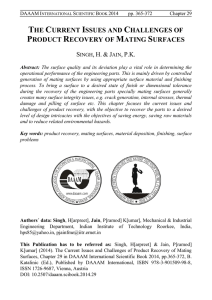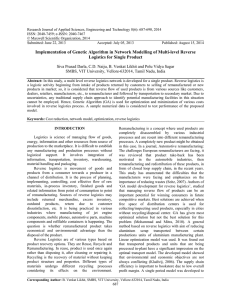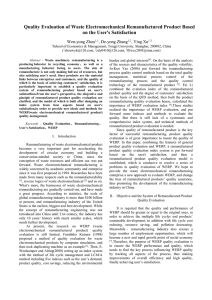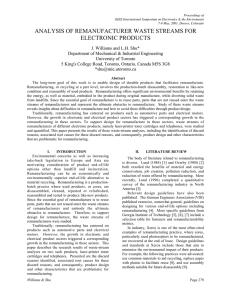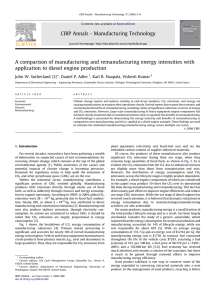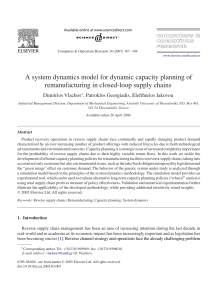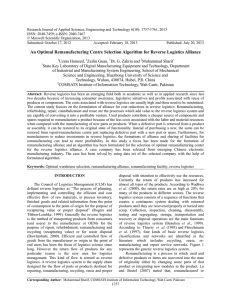Optimal Control of a Remanufacturing System K. Nakashima, H. Arimitsu, T. Nose
advertisement
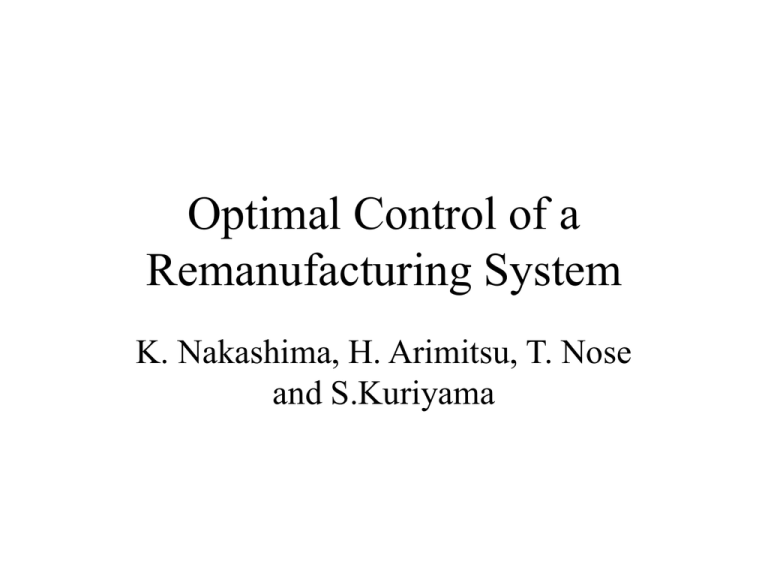
Optimal Control of a
Remanufacturing System
K. Nakashima, H. Arimitsu, T. Nose
and S.Kuriyama
What is Product Recovery?
Collection, Disassembly, Cleaning, Sorting,
Reparing, Reconditioning, Reassembly and
Testing
Why Product Recovery
• Escalating Deterioration of Environment
• Profit Motives
Inventory
•Actual Product Inventory
•Virtual Inventory
The state is defined considering both
inventories.
Then optimal production policy is obtained
to minimize the expected average cost per
period.
Literature Review
Various Models
• Periodic review models
Collected products are directly used
• Continuous review models
Remanufacturing system with non-zero lead time and control policy
with traditional (Q,r) rule
Push and pull strategy
Optimal policy for a one-product recovery system with lead time
In all these models, demand and procurement are considered independent of each
other
This papers deals with product recovery system with a single class of product
cycle.
Remanufacturing System
Factory
Customers
k
λJ(t)
J(t)
I(t)
D(t)
Imax
μJ(t)
Model
S (t ) ( I (t ), J (t ))
(1)
Transition of each inventory
I (t 1) I (t ) k J (t ) D(t ) (2)
J (t 1) J (t ) J (t ) D(t ) J (t ) (3)
The action space
K ( s(t )) 0,..., max( 0, I max I (t ) J (t )
(4)
Transition Proability
Ps (t ) s (t 1)
pr{D(t ) d } if s(t 1) ( I (t ) k J (t ) d ,
J (t ) J (t ) J (t ) d )
0 Otherwise
Expected Cost per period
r (s(t ), k ) Cn k CRJ (t ) CH I (t ) CB I (t ) Co J (t )
CH Holding cost per unit
CN Manufacturing cost
CR Remanufacturing cost
CB and Co are backorder and out of date costs
Policy Iteration
The optimality condition to minimize the expected average
cost g satisfies
g vs min r ( s, k ) pss' (k )vs '
kk ( s )
s 's
( s s)
Numerical example and summary
Parameter Values and Demand Distribution
CH : Holding cost per unit 1;
CN : Normal Manufacturing cost of a new product 2;
CR : Re manufacturing cost of a product 3;
CB : Backlog cost per unit 10;
CH : Out of date cost per unit 10;
I max : Maximum number of finished products 5;
I min : Maximum backlog permitted 5;
Maximum amount of virtual inventory 10;
: Re manufacturing rate 0.2;
: Rate of discard 0.5;
For the numerical example, the demand distribution is given as follow:
1
Q 1
Pr Dn D Q j , (0 j Q)
2
j 1
where D 2;
Q
Q is an even number ;
Variance ( 2 ) Q / 4
Optimal control policy
Given below is the optimal control policy for the remanufacturing system when
variance = 0.5. It was seen that the minimum expected cost per period, g = 11.5
Sensitivity Analysis
The variation of the of the minimum cost w.r.t remanufacturing rate and
demand variance are depicted in the following figure.
Summary
• A remanufacturing system is formulated as an undiscounted Markov
decision process.
• The stages in the system are characterized using the Actual inventory
and Virtual inventory.
• The optimal production quantity that will minimize expected average
cost is determined using the policy iterative method.

